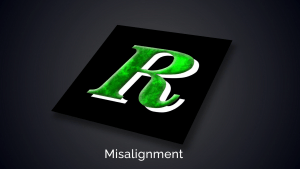 If you’re having issues with underbase alignment, it can be caused by problems with the machine you’re outputting to, or your software settings. While it might seem overwhelming to troubleshoot, how to diagnose which factor is affecting your alignment is easy with a few troubleshooting steps.
If you’re having issues with underbase alignment, it can be caused by problems with the machine you’re outputting to, or your software settings. While it might seem overwhelming to troubleshoot, how to diagnose which factor is affecting your alignment is easy with a few troubleshooting steps.
Check View Raw Data
- Import the CADlink Test Page Alignment.png or an image.
- Right-click the image and RIP Only then right-click and View Raw Data.
- Click Toggle color planes and layers
- On the Underbase layer (the top layer) and Color layer, deselect all but white.
- On the Underbase layer, double-click the white(s) and change the color to a contrasting color that is not present in the image.
- Turn the color layer on and zoom in to see if the color you selected is peeking out the edges of the image.
- When finished, remember to double-click and change the white(s) back.
If the problem exists in View Raw Data, it is software or driver related.
If you cannot see proof of the alignment issue here, continue to the next step.
Reset the queue
- Reset the queue to default and print the alignment test page.
- Double-click the job to bring up Job Properties and select Underbase > Processing Options tab.
- Set the choke to 5 and print the alignment test page.
- You can also try changing the Vertical Offset or White Color Adjust in the Printer Options tab.
Determine alignment direction (X or Y)
X = Direction of print head movement
- If printing bidirectional, try changing to unidirectional in the Printer Options tab.
Y = Direction of media movement.
- Save a PRN file by selecting File as the output port, then clicking Print.
- Clearly mark the top and bottom of the printed image and contact Technical Support.
Print Direct to Port
To see if the problem can be replicated, try testing on another machine by printing direct to port. If the problem does not replicate, the printer may be the problem.
Try this 4 to 10 times, then check if the alignment is consistent. If it is consistent, the data contains the alignment problem. However, if it looks different every print, it is the printer.
There are two very useful ports available for diagnostics with printing issues: File and Null.
Null Output
The Null port always works since it’s not really a port. It goes through the process of printing and generating the actual print data, but instead of writing this to an output port, it writes to NULL (nothing). If a queue is configured to output to Null, a job is printed, and you have an error, the error has nothing to do with the port, actual communication, or writing the data. There is something else wrong with either the driver or the queue configuration.
So if you’re having printing issues, the first test is configure the queue for Null, print a job, and see if it still gives an error. If it errors, it’s not a port or communications issue. If it works, it’s a communications issue.
To configure a queue to print to Null:
- Go to Queue > Manage Queues.
- For the queue you want to test, select Null as the output port for that queue.
- Test your queue by printing jobs.
The printing process should be normal without any output.
File Output
File output is the next level up for diagnostics after using the Null port.
File output writes the output data to a file instead of writing it to the device (i.e., a printer or cutter).
To configure a queue for File output:
- Go to Queue > Manage Queues, and in the port, select File as the output.
- Select a default location (folder) on your computer for these files to be created.
- Choose what file name will be used (in this example it will use the job name). You can also use a bar code, if using bar codes for jobs in the queue (this is mainly for cutting) or user-defined. The default file extension can be changed, by default its .prn, but you can change this to anything, for example .ar3 for Brother output.
File output should be very reliable and if you can print to Null, you should also be able to print to File. It’s only going to go wrong if you use invalid file names or locations.
If you are having problems with output, use the File output as a means to help determine where the problem lies. These files can be sent to the printer using the Tools > Direct to port feature.
You can configure various options for the File output, by clicking the ellipsis ( ) after the port (in the Queue Manager dialog).
) after the port (in the Queue Manager dialog).
Simply select the output port to which you want to print and then drag and drop the PRN (output file) into this Window to send it to the printer. This will send the file to the printer without any processing, and this way you can send the same file to the printer multiple times to see if a printing error occurs consistently (indicating it’s something in the file) or inconsistently (indicating it’s a printer issue).
You can also send the output file to another user (or your dealer or manufacturer) of the same machine and see if they can print the file to help determine the problem.
Original PDF File
To download the PDF, select it, and then click the download link in the top-right corner and save the file. You can also right-click and select Save Link As.